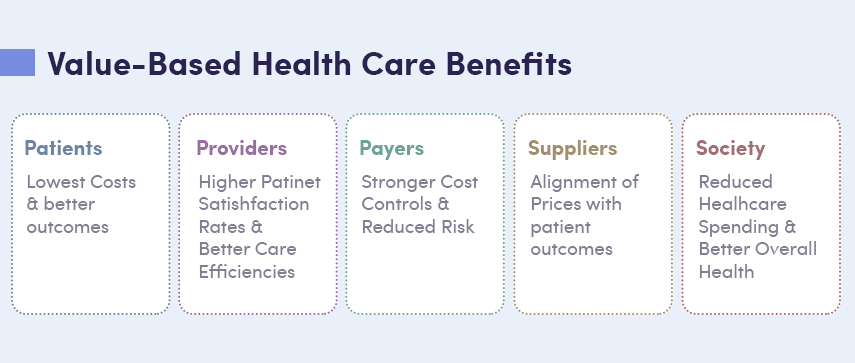As technology is evolving, we as human beings are becoming prone to multiple health hazards. People are investing millions of their hard-earned money in the healthcare industry. Even medical practitioners and hospitals have started focusing on implementing Value-based healthcare practices to reduce the overall health costs without jeopardising their patient's health.
However, you might ponder, what is exactly Value-based healthcare and how can it impact the medical industry on a global scale? The following blog post will help you majorly understand the following concepts in detail:
- What is meant by the term Value-based Care?
- How its Absence can take a toll on Patient outcomes and Management costing?
- Major benefits of Value-based Care
- How Right Analytics can Positively Impact Value-based Healthcare
So, without wasting much time, let’s begin with our first segment.
What is Value-based Care?
Value-based care is merely a healthcare delivery model that operates on how patients are treated by hospitals and physicians. As a part of the fee-for-value model, the hospitals and physicians are paid based on patient health outcomes. They must help out the patients to sustain an injury, its aftereffects and encourage them to live a healthier life.
Additionally, in this model, the ‘value’ is determined by measuring health outcomes against the cost of delivering those outcomes.
How the Absence of Value-based Care Impacts Patient Outcomes & Management Costing?
Without a properly designed fee-for-value model, patients risk their lives in terms of quality care, mental satisfaction, and health outcomes wherein they deserve better health status and value. The patients are charged a hefty amount in the name of doctor’s appointments, consultation, tests, and treatments, regardless of clinical outcome which further aggravates the issue.
On the contrary, medical practitioners' payment is directly proportional to the number of services they provide. The more they practice, the bigger is their paycheck. The greed to earn more often makes these physicians run unwanted tests and perform expensive procedures on patients. They are under the belief that running more tests will make them more confident in their diagnosis and reduce false claims.
However, such malpractice refutes the overall purpose of providing quality care to the patients and increases healthcare spending to another level benefitting only the hospital management.
Major Benefits of Value-based Care Model

The inclusion of value-based models in the health industry enforces medical practitioners to deliver their best service in terms of quality and resource utilization. Catering to such extensive usage of this model, its benefits extend to a wide audience including patients, providers, suppliers, and the overall society as a single unit.
7 Major benefits of Value-based model include the following pointers:
1 Practitioners Enhance their Efficiency & Patient Satisfaction Ratio
When medical practitioners start focusing on value instead of volume, both the quality and the patient engagement ratio takes a considerable boost. Involvement of the fee-for-value model also proves beneficial for the providers in multiple ways like:
- They are able to devote more time to understand new and prevention-based patient services while cutting down time spent on chronic disease management
- Unlike the capitated payment system model (fixed, pre-arranged monthly payments), the value-based model doesn’t place any financial risk on the providers
- Fee-for-value model also proves advantageous for profit-providers - a term which is given to those who generate revenue based on per visit
2 Despite Budget-friendly Model, Patients Health isn’t Compromised
Someone rightly quoted “Good Health doesn’t Come Cheap” and indeed it’s true. The healthcare industry is considered to be one of the most heavily invested industries across the globe. Chronic diseases like Diabetes, Cancer, High Blood Pressure, etc. can prove a burden on an individual, both in terms of finances, as well as time.
So, having a fee-for-value model acts as a boon for the patients due to the following reasons:
- It saves a lot of their time which they can utilize to finish other important tasks
- It helps them recuperate from the illness and injuries at a faster pace alongside safeguarding them from any of these chronic diseases
- Fewer doctor visits, tests, and procedures pave a way to improve their savings and encourage them to lead a healthy lifestyle
3 Payers Directly Manage Financials and Cut Down Overall Risk
Risk is usually considered inversely proportional to the number of individuals. So, having a larger count of patients would considerably reduce the implications of risk on an average basis. In other words, if the patients are healthier, it would lead to fewer claims, which would directly cut down the financial burden levied on the payers’ pockets in the form of annual premiums and other investments.
Another benefit that the fee-for-value model gives to the payers is that they can simply bundle the payments in groups wherein each group either covers the patients’ full-care cycle or is dedicated to the case of chronic diseases for a period of at most one year.
4 Patients are Well-informed About Offered Services and Other Inclusions
The thumb rule of every sales pitch is “Every Customer/Client Matters”. Operating on the same principle, several hospitals implement value-based models in their daily operations. It improves the overall patient outcomes subsequently, and ultimately improving the count of patients. As these healthcare models are patient-centric, the patients receive coordinated care 24*7 all round the year.
Using the latest technology, organizations can harness the full potential of the collected data. With authentic healthcare information, these systems further analyze data and implement corrective measures to prevent any disease spreading among individuals.
Additionally, the right coordination and timely medical assistance not only safeguard a patients’ life, but it also improves the overall efficiency of medical practitioners (physicians) and increments the number of financial rewards obtained because of it.
5 Aligning Commodities Price with Positive Patient Outcomes Benefits the Suppliers
As there is a tremendous increase in the number of positive patient outcomes with reduced costing, the suppliers too have started aligning their commodities price as per the actual value of the product. This is true especially in the case of prescribed drugs which are being purchased on a large scale.
Due to this rise in the purchase of prescribed drugs, several healthcare stakeholders have urged the manufacturers to sell these drugs on their MRP costs. With individual therapies also catching behind, the time isn’t far when this entire process will be properly streamlined and much faster.
6 Value-based healthcare Enforces a Changed Payment Paradigm
The value-based healthcare model changes the payment paradigm completely which enforces healthcare systems to become more efficient and focus on quality rather than service. The systems must deliver the highest quality of care to achieve the best outcomes within the stipulated cost budget. Implementing such a robust payment structure not only keeps patients informed about the services being offered to them, but it also ensures the payers and clinicians are well informed.
7 Encourages Healthy Lifestyle and Fitness
Under peer pressure, people often start smoking, overreacting or alcohol consumption (above the prescribed limits), which endangers their mental and physical well-being. Catering to this high utilization of alcohol and cigarettes or other narcotics, several employers modify their benefits packages to encourage healthy habits among its employees.
Organizations often reward their staff on a timely basis for showcasing healthy behavior. It can either be a simple weight-loss or leaving the habit of alcohol consumption alongside smoking. In the greed of being rewarded, other employees also start leaving their poor habits which inculcates a healthy atmosphere within the campus and the society as a whole. Furthermore, it encourages the employees to stay fit, cutting down the medical costs drastically. This saves a lot of money for the stakeholders while churning out positive health outcomes for the employees.
How Healthcare Analytics Influences Value-based Healthcare?
Customer data has become the new paradigm for enriching user-experience. With a value-based care model becoming a regular practice in several hospitals, it is time to design high-tech systems that possess the ability to gather accurate healthcare information, analyze it, and generate effective medical reports leading to positive patient health outcomes. With such massive quantities of data being fed into the systems, even organizations working in the healthcare industry need to consider how to implement analytics in their daily operations?

The right implementation of advanced healthcare analytics can enable organizations to deliver personalized medicines and understand patient needs in a better way. The right combination of technology with medical techniques allows practitioners to understand the patient outcomes, risks involved, and the overall expenses.
The medicare industry has been encouraging the Medical Shared Savings Program (MSSP) and value-based payments, and the direction they are driving towards will compel the providers to take risks. The key to dealing with these risks for providers is properly learning how to analyze data and effectively use it to their advantage. This can be done by focusing on areas where a mass of population health is in concern.
Implementing healthcare analytics in value-based care model leads to the following benefits
- It guides the professionals in selecting the right medical equipment
- It makes it easier for regulators to evaluate an organizations’ competence in providing quality service
- Based on real-time data and feedback received, manufacturers can improve device quality
- New patients can make quick decisions on device selection based on previous patient health outcomes
- It cuts down the expenditure costs across the organization
- Presence of analytics improves the quality of care and brings transparency within the processes
- Practitioners become more efficient by analyzing large datasets
Verdict
The transition from a fee-for-service model to a fee-for-value model isn’t easy due to multiple complications. But considering the pace with which the healthcare landscape is shaping, the time isn’t far when the practitioners can start getting short-term benefits. Moreover, the fee-for-value model has already been proven as the best healthcare model for lowering down the cost without compromising on the quality of care and risking people’s lives.
As per reports, physicians are geared up to manage healthcare costs, but they need more data to successfully transit into a fee-for-value model. Proper clinical support, education, staff, and technology resources are other mandatory requirements to provide quality and coordinated care to the patients.






 September 10, 2019
September 10, 2019


